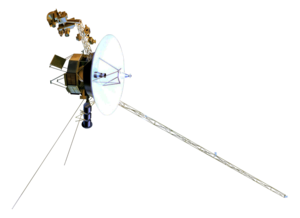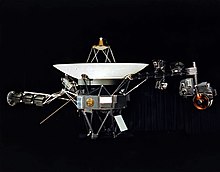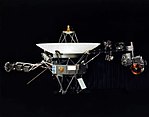Voyager 1
 Model of the Voyager spacecraft design | |
| Jenis misi | Outer planetary, heliosphere, and interstellar medium exploration |
|---|---|
| Operator | NASA / Jet Propulsion Laboratory |
| COSPAR ID | 1977-084A[1] |
| SATCAT no. | 10321[2] |
| Situs web | voyager |
| Durasi misi |
|
| Properti wahana | |
| Jenis wahana antariksa | Mariner Jupiter-Saturn |
| Produsen | Jet Propulsion Laboratory |
| Massa luncur | 8.255 kg (18.199 pon) |
| Daya | 470 watts (at launch) |
| Awal misi | |
| Tanggal luncur | September 5, 1977, 12:56:00 UTC |
| Roket peluncur | Titan IIIE |
| Tempat peluncuran | Cape Canaveral Launch Complex 41 |
| Terbang lintas Jupiter | |
| Posisi terdekat | March 5, 1979 |
| Jarak | 349.000 km (217.000 mi) |
| Terbang lintas Saturn | |
| Posisi terdekat | November 12, 1980 |
| Jarak | 124.000 km (77.000 mi) |
| Terbang lintas Titan (atmosphere study) | |
| Posisi terdekat | November 12, 1980 |
| Jarak | 6.490 km (4.030 mi) |
Voyager 1 is a space probe launched by NASA on September 5, 1977. Part of the Voyager program to study the outer Solar System, Voyager 1 was launched 16 days after its twin, Voyager 2. Having operated for 47 tahun, 2 bulan dan 8 hari as of November 14, 2024, the spacecraft still communicates with the Deep Space Network to receive routine commands and to transmit data to Earth. At a distance of 14.865 AU (2.220 miliar km; 1.380 miliar mi) from Earth as of December 26, 2019[3] it is the most distant man-made object from Earth.[4]
The probe's objectives included flybys of Jupiter, Saturn, and Saturn's largest moon, Titan. Although the spacecraft's course could have been altered to include a Pluto encounter by forgoing the Titan flyby, exploration of the moon took priority because it was known to have a substantial atmosphere.[5][6][7] Voyager 1 studied the weather, magnetic fields, and rings of the two planets and was the first probe to provide detailed images of their moons.
After completing its primary mission with the flyby of Saturn on November 12, 1980, Voyager 1 became the third of five artificial objects to achieve the escape velocity required to leave the Solar System.[butuh rujukan] On August 25, 2012, Voyager 1 became the first spacecraft to cross the heliopause and enter the interstellar medium.[8]
In a further testament to the robustness of Voyager 1, the Voyager team completed a successful test of the spacecraft's trajectory correction maneuver (TCM) thrusters in late 2017 (the first time these thrusters were fired since 1980), a project enabling the mission to be extended by two to three years.[9]
Voyager 1's extended mission is expected to continue until about 2025 when its radioisotope thermoelectric generators will no longer supply enough electric power to operate its scientific instruments.
Mission background
History
In the 1960s, a Grand Tour to study the outer planets was proposed which prompted NASA to begin work on a mission in the early 1970s.[10] Information gathered by the Pioneer 10 spacecraft helped Voyager's engineers design Voyager to cope more effectively with the intense radiation environment around Jupiter.[11] However, shortly before launch, strips of kitchen-grade aluminum foil were applied to certain cabling to further enhance radiation shielding.[12]
Initially, Voyager 1 was planned as "Mariner 11" of the Mariner program. Due to budget cuts, the mission was scaled back to be a flyby of Jupiter and Saturn and renamed the Mariner Jupiter-Saturn probes. As the program progressed, the name was later changed to Voyager, since the probe designs began to differ greatly from previous Mariner missions.[13]
Spacecraft components

Voyager 1 was constructed by the Jet Propulsion Laboratory.[14][15][16] It has 16 hydrazine thrusters, three-axis stabilization gyroscopes, and referencing instruments to keep the probe's radio antenna pointed toward Earth. Collectively, these instruments are part of the Attitude and Articulation Control Subsystem (AACS), along with redundant units of most instruments and 8 backup thrusters. The spacecraft also included 11 scientific instruments to study celestial objects such as planets as it travels through space.[17]
Communication system
The radio communication system of Voyager 1 was designed to be used up to and beyond the limits of the Solar System. The communication system includes a 37-meter (121 ft) diameter high gain Cassegrain antenna to send and receive radio waves via the three Deep Space Network stations on the Earth.[18] The craft normally transmits data to Earth over Deep Space Network Channel 18, using a frequency of either 2.3 GHz or 8.4 GHz, while signals from Earth to Voyager are transmitted at 2.1 GHz.[19]
When Voyager 1 is unable to communicate directly with the Earth, its digital tape recorder (DTR) can record about 64 kilobytes of data for transmission at another time.[20] Signals from Voyager 1 take over 20 hours to reach Earth.[3]
 Model rancangan wahana antariksa Voyager | |
| Jenis misi | Planet luar, heliosfer, dan eksplorasi medium antarbintang |
|---|---|
| Operator | NASA / Jet Propulsion Laboratory |
| COSPAR ID | 1977-084A[1] |
| SATCAT no. | 10321[2] |
| Situs web | voyager |
| Durasi misi |
|
| Properti wahana | |
| Produsen | Jet Propulsion Laboratory |
| Massa luncur | 8.255 kg (18.199 pon) |
| Daya | 420 watt (saat peluncuran) |
| Awal misi | |
| Tanggal luncur | 5 September 1977, 12.56.00 UTC (47 tahun, 2 bulan dan 9 hari) |
| Roket peluncur | Titan IIIE |
| Tempat peluncuran | Cape Canaveral LC-41 |
| Terbang lintas Jupiter | |
| Posisi terdekat | 5 Maret 1979 |
| Jarak | 349.000 km (217.000 mi) |
| Terbang lintas Saturnus | |
| Posisi terdekat | 12 November 1980 |
| Jarak | 124.000 km (77.000 mi) |
| Terbang lintas Titan (studi atmosfer) | |
| Posisi terdekat | 12 November 1980 |
| Jarak | 6.490 km (4.030 mi) |

Voyager 1 adalah sebuah wahana antariksa nirawak yang diluncurkan pada 5 September 1977 oleh NASA. Voyager 1 merupakan bagian dari program Voyager yang bertujuan untuk mempelajari Tata Surya bagian luar, yang diluncurkan 16 hari setelah Voyager 2. benda buatan manusia yang terjauh dari bumi pada 21,4 miliar kilometer dari bumi(per 3 Juni 2018) dan memasuki heliosheath setelah melewati termination shock yang membatasi tata surya. Pada jarak tersebut, sinyal dari Voyager 1 perlu lebih dari 36 jam untuk sampai ke pusat kontrolnya, Jet Propulsion Laboratory di dekat Pasadena, California yang merupakan proyek bersama NASA dan Caltech.
Saat diluncurkan, tujuan utama Voyager 1 adalah menyelidiki Jupiter dan Saturnus serta cincin dan bulan kedua planet tersebut. Sekarang, Voyager 1 sedang menyelidiki heliopause dan medium antar-bintang. Listrik Voyager 1 dibangkitkan menggunakan pembangkit termolistrik radioisotop (radioisotope thermoelectric generator) dan diperkirakan masih akan terus tersedia dan menyalurkan komunikasi dengan Bumi hingga sekitar tahun 2020. Saat ini (per 1 Agustus 2015), Voyager 1 meluncur pada kecepatan sekitar 72.000 kilometer per jam.
Voyager 1 akan menjadi interstellar probe selamanya seperti Pioneer 10, Pioneer 11, dan Voyager 2.
Deskripsi

Voyager I adalah pesawat ruang angkasa tanpa awak seberat 733 kg yang berhasil mengunjungi Jupiter dan Saturnus di akhir tahun 70an dan awal 80an.
Saat ini, Voyager I merupakan objek buatan manusia dengan posisi terjauh dari bumi, dengan jarak sekitar 100 Unit Astronomi atau sekitar 14 jam cahaya.
Wahana ini sekarang berada di bagian luar tata surya yang disebut heliosheath, di mana angin matahari terkompresi dan menjadi bergolak oleh interaksi dengan medium antarbintang.
Meskipun jauh, Voyager I masih berada di wilayah sabuk Kuiper, sebuah sabuk asteroid besar yang terletak di luar orbit Neptunus.
Dengan penggerak generator termal radioisotop, Voyager I memiliki daya yang cukup untuk mengoperasikan instrumen sampai kira-kira tahun 2025, sebelum akhirnya mati.
Para ilmuwan berharap sebelum kematiannya, Voyager I telah mencapai wilayah di luar heliosheath sehingga mampu mengirimkan analisis medium antarbintang untuk pertama kalinya.
Voyager I memiliki sejarah yang unik. Wahana ini diluncurkan pada 5 September 1977, dan berhasil memberikan gambar resolusi tinggi pertama atas bulan Jupiter dan Saturnus, termasuk Callisto, Io, Titan, Ganymede, dan banyak lainnya.
Pada Januari 1979, Voyager I melewati Jupiter dan hanya berjarak 349.000 kilometer dari pusatnya.
Voyager I berhasil mengamati adanya aktivitas gunung berapi di bulan Jupiter, Io, yang belum pernah teramati sebelumnya oleh teleskop atau dua wahana lain yang mengunjungi Jupiter sebelumnya, Pioneer 10 dan Pioneer 11.
Io mengorbit sangat dekat dengan Jupiter dan memiliki kondisi geologi sangat aktif karena kedekatannya dengan medan magnet Jupiter yang amat kuat.
Pada November 1980, Voyager I mengunjungi Saturnus, dengan posisi terdekat dicapai pada tanggal 12 November dengan jarak 124.000 kilometer dari puncak awan Saturnus.
Voyager I juga berhasil membuat pengamatan pada cincin dan bulan Saturnus, terutama Titan, yang memiliki atmosfer sendiri.
Para ilmuwan kemudian mengirim Voyager I mendekati Titan untuk mengamatinya lebih jauh, membuat Titan menjadi objek tata surya terakhir yang didekati, sebelum wahana ini melanjutkan perjalanan ke luar tata surya.
Peluncuran

Awalnya, Voyager 1 adalah Mariner 11 untuk Program Mariner. Secara kebetulan, teknologi Gravitational Slingshot yang digunakan waktunya cocok dengan susunan planet yang memungkinkan penggunaan gravitasi planet untuk pesawat luar angkasa tersebut atau Planetary Grand Tour.
Voyager 1 diluncurkan setelah Voyager 2 pada 5 September 1977 dan diset pada jalur yang membuatnya lebih cepat sampai Jupiter dan Saturnus.
Secara resmi NASA telah menyatakan bahwa Voyager 1 telah meninggalkan tata surya dan kini berada di Interstellar space atau ruang antar bintang.
Instrumen ilmiah
| Nama Instrumen | Abr. | Deskripsi | ||||||||||||||||||||||||||||||||||||||||||||||||||||||||||||||||||||||||||||||||||||||||||||
|---|---|---|---|---|---|---|---|---|---|---|---|---|---|---|---|---|---|---|---|---|---|---|---|---|---|---|---|---|---|---|---|---|---|---|---|---|---|---|---|---|---|---|---|---|---|---|---|---|---|---|---|---|---|---|---|---|---|---|---|---|---|---|---|---|---|---|---|---|---|---|---|---|---|---|---|---|---|---|---|---|---|---|---|---|---|---|---|---|---|---|---|---|---|---|
| Imaging Science System (dimatikan) |
(ISS) | Dimanfaatkan sistem dua kamera (narrow-angle/wide-angle) untuk memberikan citra Jupiter, Saturnus dan benda-benda lainnya di sepanjang lintasan. More
| ||||||||||||||||||||||||||||||||||||||||||||||||||||||||||||||||||||||||||||||||||||||||||||
| Radio Science System (dimatikan) |
(RSS) | Memanfaatkan sistem telekomunikasi dari pesawat ruang angkasa Voyager untuk menentukan sifat fisik planet dan satelit (ionosfer, atmosfer, massa, bidang gravitasi, kepadatan) dan jumlah dan distribusi ukuran materi dalam cincin Saturnus dan dimensi cincin. More
| ||||||||||||||||||||||||||||||||||||||||||||||||||||||||||||||||||||||||||||||||||||||||||||
| Infrared Interferometer Spectrometer (dimatikan) |
(IRIS) | Menelaah keseimbangan energi global dan lokal dan komposisi atmosfer. Profil suhu vertikal juga diperoleh dari planet-planet dan satelit serta komposisi, sifat termal, dan ukuran partikel dalam cincin Saturnus. More
| ||||||||||||||||||||||||||||||||||||||||||||||||||||||||||||||||||||||||||||||||||||||||||||
| Ultraviolet Spectrometer (aktif) |
(UVS) | Dirancang untuk mengukur sifat atmosfer, dan untuk mengukur radiasi. More
| ||||||||||||||||||||||||||||||||||||||||||||||||||||||||||||||||||||||||||||||||||||||||||||
| Triaxial Fluxgate Magnetometer (aktif) |
(MAG) | Dirancang untuk menyelidiki medan magnet Jupiter dan Saturnus, interaksi angin surya dengan magnetospheres planet ini, dan medan magnet dari ruang antarplanet ke batas antara angin matahari dan medan magnet ruang antarbintang, jika menyeberang. More
| ||||||||||||||||||||||||||||||||||||||||||||||||||||||||||||||||||||||||||||||||||||||||||||
| Plasma Spectrometer (cacat) |
(PLS) | Menyelidiki sifat makroskopik dari ion plasma dan langkah-langkah elektron dalam kisaran energi dari 5 eV sampai 1 keV. More
| ||||||||||||||||||||||||||||||||||||||||||||||||||||||||||||||||||||||||||||||||||||||||||||
| Low Energy Charged Particle Instrument (aktif) |
(LECP) | Mengukur diferensial dalam fluks energi dan distribusi sudut ion, elektron dan diferensial dalam komposisi ion energi. More
| ||||||||||||||||||||||||||||||||||||||||||||||||||||||||||||||||||||||||||||||||||||||||||||
| Cosmic Ray System (aktif) |
(CRS) | Menentukan asal dan proses percepatan, riwayat hidup, dan kontribusi dinamis sinar kosmik antar bintang, nukleosintesis elemen dalam sumber kosmik-ray, perilaku sinar kosmik dalam medium antarplanet, dan planet terjebak energik-lingkungan partikel. More
| ||||||||||||||||||||||||||||||||||||||||||||||||||||||||||||||||||||||||||||||||||||||||||||
| Planetary Radio Astronomy Investigation (dimatikan) |
(PRA) | Memanfaatkan frekuensi radio penerima menyapu untuk mempelajari sinyal radio-emisi dari Jupiter dan Saturnus. More
| ||||||||||||||||||||||||||||||||||||||||||||||||||||||||||||||||||||||||||||||||||||||||||||
| Photopolarimeter System (cacat) |
(PPS) | Memanfaatkan teleskop dengan polarizer untuk mengumpulkan informasi tentang tekstur permukaan dan komposisi Jupiter dan Saturnus dan informasi tentang sifat hamburan atmosfer dan kepadatan untuk kedua planet. More
| ||||||||||||||||||||||||||||||||||||||||||||||||||||||||||||||||||||||||||||||||||||||||||||
| Plasma Wave System (aktif) |
(PWS) | Menyediakan kontinu, pengukuran selubung-independen dari profil elektron-density di Jupiter dan Saturnus serta informasi dasar tentang interaksi gelombang-partikel lokal, berguna dalam mempelajari magnetospheres. More
| ||||||||||||||||||||||||||||||||||||||||||||||||||||||||||||||||||||||||||||||||||||||||||||
Catatan Misi
| Tanggal | Kejadian |
|---|---|
| 5 September 1977 | Voyager 1 Diluncurkan |
| 10 Desember 1977 | Memasuki Sabuk Asteroid |
| 19 Desember 1977 | Voyager 1 menyalip Voyager 2 |
| 6 Januari 1979 | Memulai mengobservasi planet Jupiter |
| 22 Agustus 1980 | Memulai mengobservasi planet Saturnus |
| 14 Desember 1980 | Memulai memperpanjang misi |
Referensi
- ^ a b "Voyager 1". NSSDC Master Catalog. NASA/NSSDC. Diakses tanggal August 21, 2013. Kesalahan pengutipan: Tanda
<ref>tidak sah; nama "nasa.084A" didefinisikan berulang dengan isi berbeda - ^ a b "Voyager 1". N2YO. Diakses tanggal August 21, 2013. Kesalahan pengutipan: Tanda
<ref>tidak sah; nama "n2yo.10321" didefinisikan berulang dengan isi berbeda - ^ a b "Voyager - Mission Status". Jet Propulsion Laboratory. National Aeronautics and Space Administration. Diakses tanggal December 26, 2019.,
- ^ "Voyager 1". BBC Solar System. Diarsipkan dari versi asli tanggal February 3, 2018. Diakses tanggal September 4, 2018.
- ^ Kesalahan pengutipan: Tag
<ref>tidak sah; tidak ditemukan teks untuk ref bernamafaq - ^ "New Horizons conducts flyby of Pluto in historic Kuiper Belt encounter". Diakses tanggal September 2, 2015.
- ^ "What If Voyager Had Explored Pluto?". Diakses tanggal September 2, 2015.
- ^ Barnes, Brooks (September 12, 2013). "In a Breathtaking First, NASA Craft Exits the Solar System". New York Times. Diakses tanggal September 12, 2013.
- ^ Wall, Mike (December 1, 2017). "Voyager 1 Just Fired Up its Backup Thrusters for the 1st Time in 37 Years". Space.com. Diakses tanggal December 3, 2017.
- ^ "1960s". JPL. Diarsipkan dari versi asli tanggal December 8, 2012. Diakses tanggal August 18, 2013.
- ^ "The Pioneer missions". NASA. 2007. Diakses tanggal August 19, 2013.
- ^ "Preview Screening: The Farthest - Voyager in Space". informal.jpl.nasa.gov. NASA Museum Alliance. August 2017. Diakses tanggal August 18, 2019.
supermarket aluminum foil added at the last minute to protect the craft from radiation
- ^ Mack, Pamela (1998). "Chapter 11". From engineering science to big science: The NACA and NASA Collier Trophy research project winners. History Office. hlm. 251. ISBN 978-0-16-049640-0.
- ^ Landau, Elizabeth (October 2, 2013). "Voyager 1 becomes first human-made object to leave solar system". CNN. CNN. Diakses tanggal May 29, 2014.
- ^ "NASA Spacecraft Embarks on Historic Journey into Interstellar Space". NASA. September 12, 2013. Diakses tanggal May 29, 2014.
NASA's Voyager 1 spacecraft officially is the first human-made object to venture into interstellar space.
- ^ "Viking: Trailblazer for All Mars Research". NASA. June 22, 2006. Diakses tanggal May 29, 2014.
All of these missions relied on Viking technologies. As it did for the Viking program team in 1976, Mars continues to hold a special fascination. Thanks to the dedication of men and women working at NASA centers across the country, the mysterious Mars of our past is becoming a much more familiar place.
- ^ "VOYAGER 1:Host Information". JPL. 1989. Diakses tanggal April 29, 2015.
- ^ "High Gain Antenna". JPL. Diakses tanggal August 18, 2013.
- ^ Ludwig, Roger; Taylor, Jim (March 2002). "Voyager Telecommunications" (PDF). DESCANSO Design and Performance Summary Series. NASA/JPL. Diakses tanggal September 16, 2013.
- ^ "NASA News Press Kit 77–136". JPL/NASA. Diakses tanggal December 15, 2014.
- ^ "Voyager 1 Narrow Angle Camera Description". NASA. Diakses tanggal January 17, 2011.
- ^ "Voyager 1 Wide Angle Camera Description". NASA. Diakses tanggal January 17, 2011.
Pranala luar
- (Inggris) Situs Voyager dari NASA
- (Indonesia) [1]











